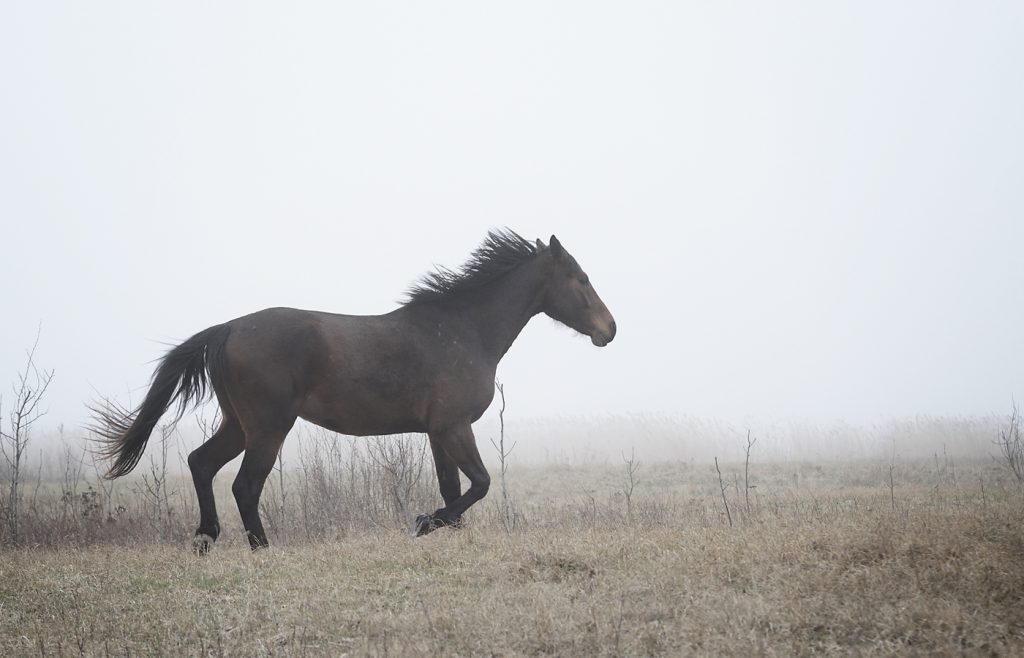
How do you catch your horse? Okay. I’m going to make a provocative statement: Don’t let the horse win. That may sound disrespectful of one of my all-time favorite books, The 7 Habits of Highly Effective People, by Steven Covey. After all, one of the habits is to “think win-win.” I think win-win most of the time, yet there are many times when bad things would happen if the horse wins—like when you’re trying to catch your horse.
Let me explain. When your horses live at liberty in a pasture, which mine do, and you want to catch one, you could spend the greater part of a day chasing him around trying to halter him. If the horse wins this game, even once, the stage is set for hours of frustration down the road. The problem is the way we communicate with the horse when we approach him.
If we approach him with serious intentions and move directly toward his head, the horse thinks that we might be a predator. Out of instinct, the horse moves away from us to think it over. If we approach the horse from behind, we may frighten him and he’ll move away. Watch horses in a herd and you’ll notice that they walk towards each other in seemingly random patterns. The patterns aren’t that random if you know how to watch. Horses mosey in a general direction, stop, come a little closer, stop again, and almost always approach each other at a 45-degree angle, towards the shoulder. Once I learned how to approach a horse and chose to invest as much time as it took to win—meaning to catch a horse—life became better for horse and human.
I learned a lot about catching and winning from my Arabian horse, Chance. The previous owners had a lot of “buts” to share with me about Chance when I acquired him. “He’s very sweet, but . . . he doesn’t like to be caught. He’s very sweet, but . . . he doesn’t like to have a bit in his mouth. He’s very sweet, but . . . he doesn’t like to trot, he prefers to canter. He’s very sweet, but . . . he doesn’t like his feet worked on.”
It was clear to me that Chance needed to learn a lot about his communications with humans. He was winning way too often. I was determined to change his patterns of behavior. And it worked. Chance has slowly learned that it is okay to let me win. Life got very, very good after that.
Early on, I can’t tell you how many times I would approach Chance and back off, move closer, back off, until I would get within 60 feet of him, then within 30 feet, 10 feet, 3 feet, and then finally, right up to him. Several times he would walk off when I got too close for his comfort. I would stand my ground, not stare at him, turn my body away from Chance, and then start again. In the first few weeks, it took up to 45 minutes for me to catch him. But I always prevailed. Now, many months later, not only is Chance not hard to catch, he approaches me when I arrive in the pasture. Catching him takes all of one to two minutes.
Once in a while, Chance still tests me and walks off, as if he’s thinking, “You want to catch me and work me hard today and I’m not so sure about that.” I laugh, shake my head, and say to myself, “Chance, you know I’m committed to catching you no matter how long it takes.” Chance will walk away five or six feet, then turn and look at me as if to say “Are we going to play this game, or what?” I will move toward his shoulder, not toward his head, or even maybe walk a few steps away from him, then come around and approach him from the other shoulder, and then he will allow himself to be caught.
Ultimately, I think that when I win this game, Chance wins too. It strengthens our bond, it creates mutual trust, and it allows me to continue to learn by Chance.
On a practical note, it’s important to be prepared to catch your horse. If you walk up to him and he is standing patiently, but you start fumbling with the lead rope and unbuckling the halter, your horse will get impatient or see your behavior as a signal that you’re not ready and take the opportunity to walk away.
Here’s what to do. Hold the lead rope, snapped to an unbuckled halter, in your left hand. The lead rope must not be looped around your hand, but folded, so that if the horse pulls you can just let go and your hand won’t get caught. Have the halter open with the buckle towards your left hand and the open part of the halter toward your right hand, so when you approach the horse you can slip the lead rope around his neck and then reach ove rhis neck. Then you can grab the right side of the halter, lift it up over the horse’s neck as you put his nose into the halter, and buckle the halter. It’s really quite easy.
A Boy Scout’s motto is “Be Prepared.” It works with horses, too.
